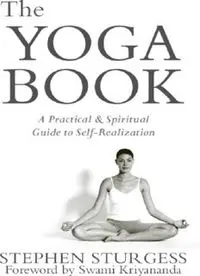
The Yoga Book: A Practical Guide to Self-realization Through the Practice of Ashtanga Yoga PDF
Preview The Yoga Book: A Practical Guide to Self-realization Through the Practice of Ashtanga Yoga
The YOGA BOOK A PRACTICAL GUIDE TO SELF- REALIZATION STEPHEN STURGESS Foreword by Swami Kriyananda WATKINS PUBLISHING LONDON 2 DEDICATION This book is dedicated to my spiritual masters, Jesus Christ, Krishna, Babaji, Lahiri Mahasaya, Swami Sri Yukteswar and my beloved Master Paramhansa Yogananda who has shown me the true path to God. I also dedicate this book to Sri Kriyananda, who inspired me to follow the Kriya Yoga teachings of Yogananda. This book is for all my spiritual brothers and sisters at Ananda and for all those who have helped me along the way to Truth. May this book inspire you, the reader, to live in the consciousness of God, that you may find the true inner joy and inner peace. 3 Stephen Sturgess was first introduced to yoga in 1969. He has studied their teachings and practised yoga under well-known yoga masters. These include three of Swami Sivananda's foremost direct disciples: Swami Satyananda Saraswati, Swami Venkatesananda, and Swami Vishnudevananda, who were making regular visits to England during the 1970s to give yoga seminars, workshops and retreats. This was a very inspiring time for Stephen to meet these spiritually wise yoga teachers from India, who prepared the way for higher teachings. Another excellent yoga teacher Stephen studied under was the late Yoga Maharishi Dr Swami Gitananda of Pondicherry, India. In 1979 Stephen was given the spiritual name of ‘Shankara’ (‘the auspicious one’) and given mantra initiation by Swami Satyananda Saraswati. Then, after meeting many other spiritual teachers and exploring the different paths of yoga, and practising them, Stephen met his spiritual teacher, Swami Kriyananda (a direct disciple of Paramhansa Yogananda) in London in 1982. Swami Kriyananda (Founder/Director of the Ananda Spiritual Communities in Nevada, California, USA and Assisi, Italy) initiated Stephen into the ancient science of Kriya Yoga meditation techniques and teachings that Mahavatar Babaji passed down in disciplic succession to Yogananda. Stephen is the Ananda Meditation Group leader for the United Kingdom. He teaches yoga and meditation and is available to give yoga/meditation workshops on request. Stephen is also a spiritual healer, artist and graphic designer, living in London. 4 By the same author Yoga For Life 5 CONTENTS Acknowledgements Dedication Preface What Is Yoga? Foreword by Sri Kriyananda 1 The Subtle Bodies and the Chakras The Physical Body The Astral Body The Causal Body The Soul The Chakras: Your Inner Universe Locating the Chakras 2 Yama Ashtanga Yoga: The Eight Limbs of Yoga The Relationship between Yama and Niyama The Principles and Practice of Yama Ahimsa: Non-violence, Non-injury, Non-harming Satya: Non-lying, Truthfulness 6 Asteya: Non-stealing Brahmacharya: Non-sensuality Aparigraha: Non-attachment, Non-greed 3 Niyama Saucha: Cleanliness, Purity Santosha: Contentment Tapas: Austerity Svadhaya: Self-study Isvarapranidhana: Surrender to God 4 Asana What is Hatha Yoga? Purification Fasting for Purification The Yogic Diet Bandhas Mudras 5 Pranayama Prana, the Vital Energy of the Universe The Five Life—Forces of the Body Guidelines for the Practice of Pranayama Swara Yoga Four Different Methods of Breathing Hand Mudras for controlling the breath Pranayama Techniques Pranic Healing 7 6 Pratyahara The Senses The Practice of Pratyahara 7 Dharana Achieving Dharana Interiorizing and Concentrating the Mind Other Techniques that Help Concentration 8 Dhyana Why We Need to Meditate The Practice of Meditation Kriya Yoga: An Advanced Spiritual Accelerator 9 Samadhi The Difference Between Meditation (Dhyana) and Samadhi The Stages of Samadhi Further Reading Useful Addresses Other Resources Glossary 8 LIST OF ILLUSTRATIONS Figure 1 The subtle bodies and the chakras Figure 2 The five sheaths of consciousness Figure 3 Body regions of the five vayus (vital airs) Figure 4 The seven chakras (centres of consciousness) are situated in the astral body. Here they are shown in relation to the physical body. Figure 5 The chakras and nadis (subtle nerve pathways) in the astral body Figure 6 The endocrine glands Figure 7 The nerve plexuses Figure 8 Padangushthasana (toe-balance pose) Figure 9 Viryastambhanasana (semen-retention pose) Figure 10 Bhadrasana (nobility pose) Figure 11 Chanting with mala beads Figure 12 The digestive system, showing the flow of warm salt water in the practice of shankhaprakshalana Figure 13 Shankaprakshalana Figure 14 Pavanamuktasana (gas- and wind-eliminating pose) Figure 15 Nauli kriya Figure 16 Nabho mudra Figure 17 Kechari mudra Figure 18 Ustrasana (camel pose) Figure 19 Yogic breathing Figure 20 Position for meditation seated on a chair Figure 21 Sukhasana Figure 22 Swastikasana Figure 23 Siddhasana Figure 24 Padmasana (lotus pose) Figure 25 Ardha padmasana 9 ACKNOWLEDGEMENTS This book took nearly four years to write. The knowledge and experience I gained from various yogic paths and spiritual disciplines over 23 years inspired me to write a comprehensive book on Ashtanga Yoga to inspire others to raise their consciousness to a higher level so that they will know the purpose of this life and feel God's presence in their hearts. I give my deepest thanks and appreciation to Jeanne Cook, who spent many hours typing the manuscript for me. I am profoundly grateful to Sri Kriyananda, who very kindly wrote the Foreword for this book, also for his comments and inspirational support. I give appreciation and thanks also to all other people who may have contributed to the creation of this book, or who inspired me. 10
